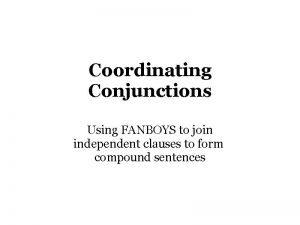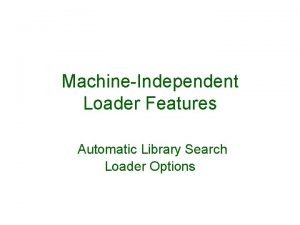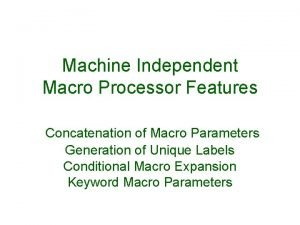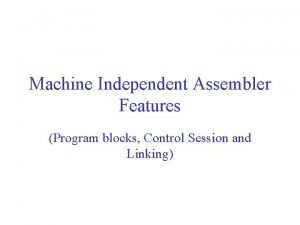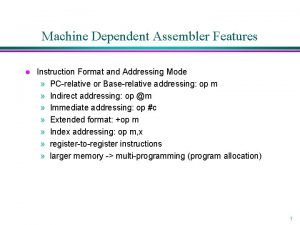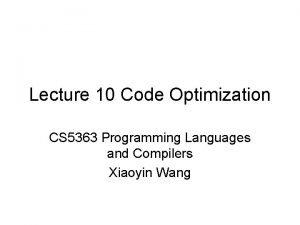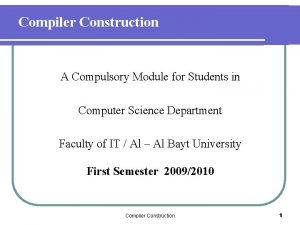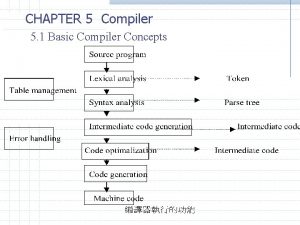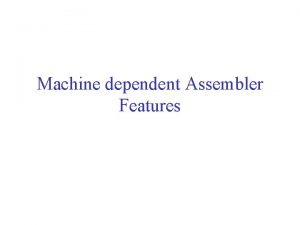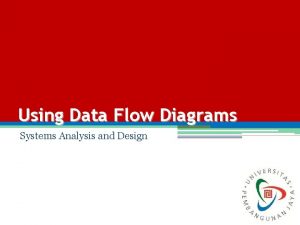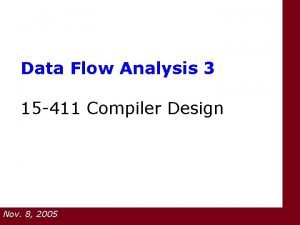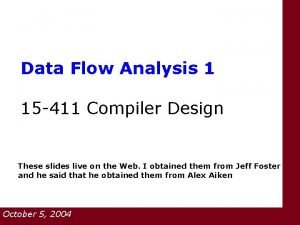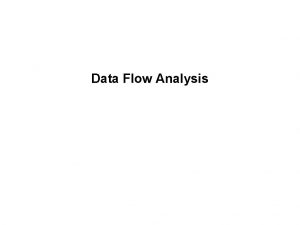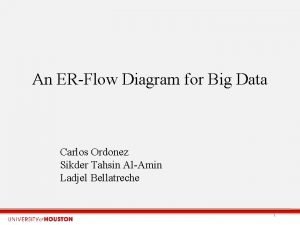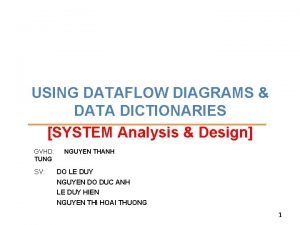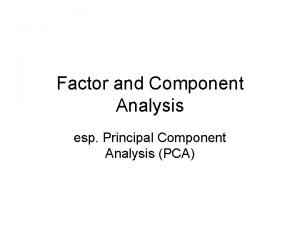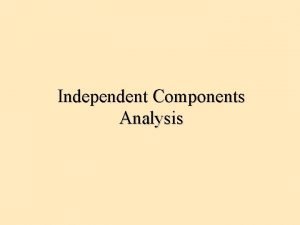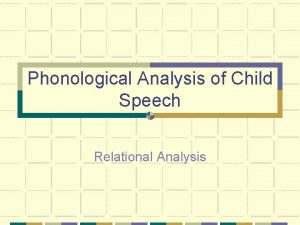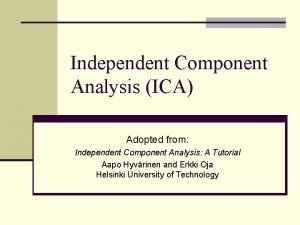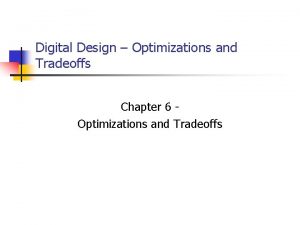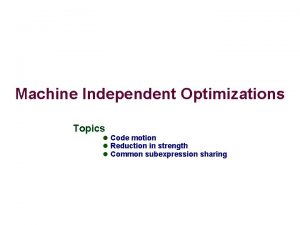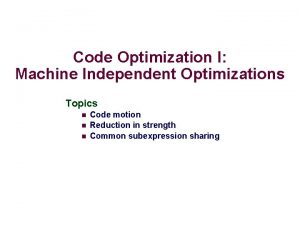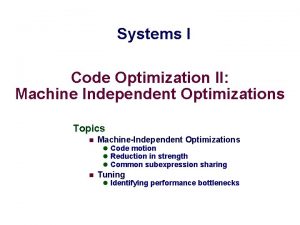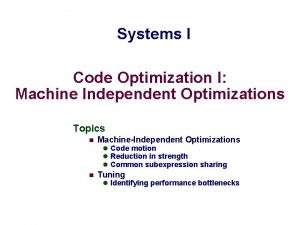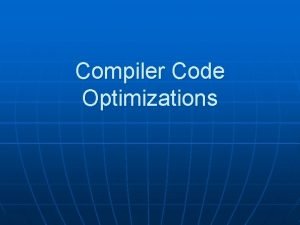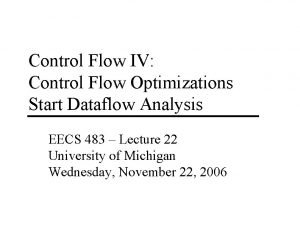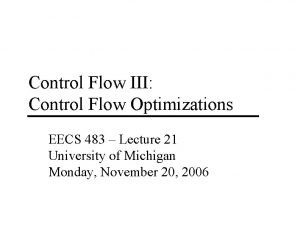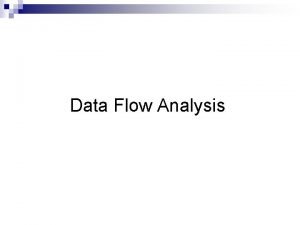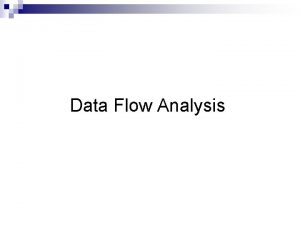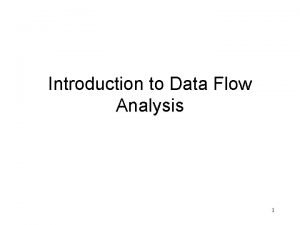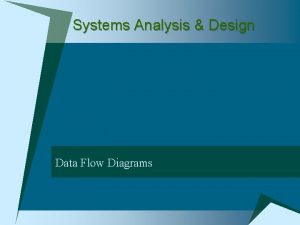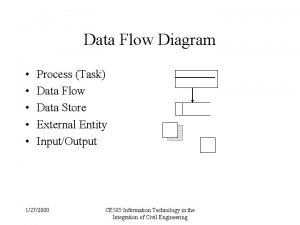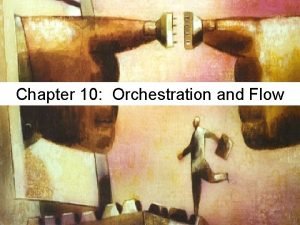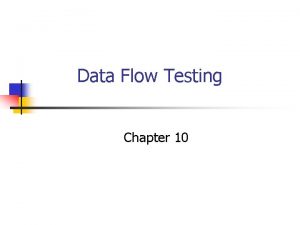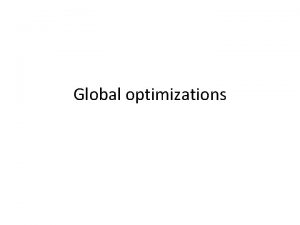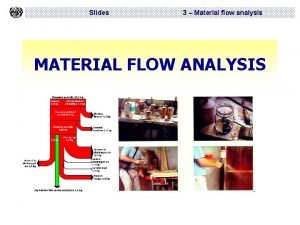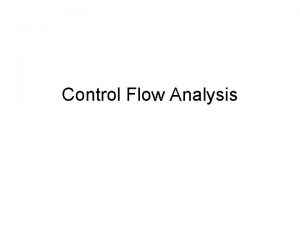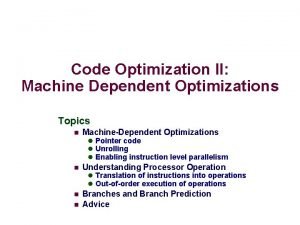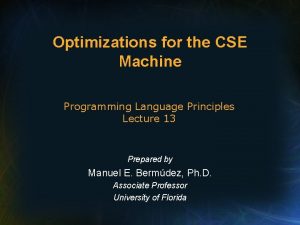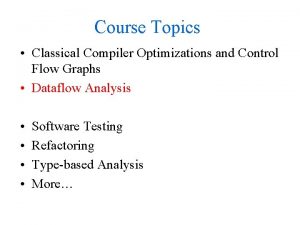Chapter 9 Machine Independent Optimizations Data Flow Analysis
















![Data Flow Equations IN[B]: Definitions that reach B’s entry. OUT[B]: Definitions that reach B’s Data Flow Equations IN[B]: Definitions that reach B’s entry. OUT[B]: Definitions that reach B’s](https://slidetodoc.com/presentation_image/3a646e07ba583fa29c2e063cec48fc7a/image-17.jpg)




![Data Flow Equations IN[B]: Expressions available at B’s entry. OUT[B]: Expressions available at B’s Data Flow Equations IN[B]: Expressions available at B’s entry. OUT[B]: Expressions available at B’s](https://slidetodoc.com/presentation_image/3a646e07ba583fa29c2e063cec48fc7a/image-22.jpg)


![Data Flow Equations IN[B]: Variables live at B’s entry. OUT[B]: Variables live at B’s Data Flow Equations IN[B]: Variables live at B’s entry. OUT[B]: Variables live at B’s](https://slidetodoc.com/presentation_image/3a646e07ba583fa29c2e063cec48fc7a/image-25.jpg)



![Data Flow Equations IN[B]: Expressions very busy at B’s entry. OUT[B]: Expressions very busy Data Flow Equations IN[B]: Expressions very busy at B’s entry. OUT[B]: Expressions very busy](https://slidetodoc.com/presentation_image/3a646e07ba583fa29c2e063cec48fc7a/image-29.jpg)














- Slides: 43

Chapter 9 Machine. Independent Optimizations










Data Flow Analysis Data flow analysis is used to collect information about the flow of data values across basic blocks. • Dominator analysis collected global information regarding the program’s structure • For performing global code optimizations global information must be collected regarding values of program variables. – Local optimizations involve statements from same basic block – Global optimizations involve statements from different basic blocks data flow analysis is performed to collect global information that drives global optimizations 11

Local and Global Optimization 12

1. Reaching Definitions Definition d of variable v: a statement d that assigns a value to v. Use of variable v: reference to value of v in an expression evaluation. Definition d of variable v reaches a point p if there exists a path from immediately after d to p such that definition d is not killed along the path. Definition d is killed along a path between two points if there exists an assignment to variable v along the path. 13

Example d reaches u along path 2 & d does not reach u along path 1 Since there exists a path from d to u along which d is not killed (i. e. , path 2), d reaches u. 14

Reaching Definitions Contd. Unambiguous Definition: X = …. ; Ambiguous Definition: *p = …. ; p may point to X For computing reaching definitions, typically X=. . by unambiguous we only consider kills definitions. *p=. . Does definition of X reach here ? Yes 15

Computing Reaching Definitions At each program point p, we compute the set of definitions that reach point p. Reaching definitions are computed by solving a system of equations (data flow equations). d 2: X=… d 3: X=… IN[B] OUT[B] d 1: X=… GEN[B] ={d 1} KILL[B]={d 2, d 3} 16
![Data Flow Equations INB Definitions that reach Bs entry OUTB Definitions that reach Bs Data Flow Equations IN[B]: Definitions that reach B’s entry. OUT[B]: Definitions that reach B’s](https://slidetodoc.com/presentation_image/3a646e07ba583fa29c2e063cec48fc7a/image-17.jpg)
Data Flow Equations IN[B]: Definitions that reach B’s entry. OUT[B]: Definitions that reach B’s exit. GEN[B]: Definitions within B that reach the end of B. KILL[B]: Definitions that never reach the end of B due to redefinitions of variables in B. 17

Reaching Definitions Contd. • Forward problem – information flows forward in the direction of edges. • May problem – there is a path along which definition reaches a point but it does not always reach the point. Therefore in a May problem the meet operator is the Union operator. 18

Applications of Reaching Definitions • Constant Propagation/folding • Copy Propagation 19

2. Available Expressions An expression is generated at a point if it is computed at that point. An expression is killed by redefinitions of operands of the expression. An expression A+B is available at a point if every path from the start node to the point evaluates A+B and after the last evaluation of A+B on each path there is no redefinition of either A or B (i. e. , A+B is not killed). 20

Available Expressions Available expressions problem computes: at each program point the set of expressions available at that point. 21
![Data Flow Equations INB Expressions available at Bs entry OUTB Expressions available at Bs Data Flow Equations IN[B]: Expressions available at B’s entry. OUT[B]: Expressions available at B’s](https://slidetodoc.com/presentation_image/3a646e07ba583fa29c2e063cec48fc7a/image-22.jpg)
Data Flow Equations IN[B]: Expressions available at B’s entry. OUT[B]: Expressions available at B’s exit. GEN[B]: Expressions computed within B that are available at the end of B. KILL[B]: Expressions whose operands are redefined in B. 22

Available Expressions Contd. • Forward problem – information flows forward in the direction of edges. • Must problem – expression is definitely available at a point along all paths. Therefore in a Must problem the meet operator is the Intersection operator. • Application: A 23

3. Live Variable Analysis A path is X-clear is it contains no definition of X. A variable X is live at point p if there exists a X-clear path from p to a use of X; otherwise X is dead at p. Live Variable Analysis Computes: At each program point p identify the set of variables that are live at p. 24
![Data Flow Equations INB Variables live at Bs entry OUTB Variables live at Bs Data Flow Equations IN[B]: Variables live at B’s entry. OUT[B]: Variables live at B’s](https://slidetodoc.com/presentation_image/3a646e07ba583fa29c2e063cec48fc7a/image-25.jpg)
Data Flow Equations IN[B]: Variables live at B’s entry. OUT[B]: Variables live at B’s exit. GEN[B]: Variables that are used in B prior to their definition in B. KILL[B]: Variables definitely assigned value in B before any use of that variable in B. 25

Live Variables Contd. • Backward problem – information flows backward in reverse of the direction of edges. • May problem – there exists a path along which a use is encountered. Therefore in a May problem the meet operator is the Union operator. 26

Applications of Live Variables • Register Allocation • Dead Code Elimination • Code Motion Out of Loops 27

4. Very Busy Expressions A expression A+B is very busy at point p if for all paths starting at p and ending at the end of the program, an evaluation of A+B appears before any definition of A or B. Application: Code Size Reduction Compute for each program point the set of very busy expressions at the point. 28
![Data Flow Equations INB Expressions very busy at Bs entry OUTB Expressions very busy Data Flow Equations IN[B]: Expressions very busy at B’s entry. OUT[B]: Expressions very busy](https://slidetodoc.com/presentation_image/3a646e07ba583fa29c2e063cec48fc7a/image-29.jpg)
Data Flow Equations IN[B]: Expressions very busy at B’s entry. OUT[B]: Expressions very busy at B’s exit. GEN[B]: Expression computed in B and variables used in the expression are not redefined in B prior to expression’s evaluation in B. KILL[B]: Expressions that use variables that are redefined in B. 29

Very Busy Expressions Contd. • Backward problem – information flows backward in reverse of the direction of edges. • Must problem – expressions must be computed along all paths. Therefore in a Must problem the meet operator is the Intersection operator. 30

Summary May/Union Must/Intersecti on Forward Reaching Definitions Available Expressions Backward Live Variables Very Busy Expressions 31

Conservative Analysis Optimizations that we apply must be Safe => the data flow facts we compute should definitely be true (not simply possibly true). Two main reasons that cause results of analysis to be conservative: 1. Control Flow 2. Pointers & Aliasing 32

Conservative Analysis 1. Control Flow – we assume that all paths are executable; however, some may be infeasible. X+Y is always available if we exclude infeasible paths. 33

Conservative Analysis 2. Pointers & Aliasing – we may not know what a pointer points to. 1. X = 5 2. *p = … 3. … = X // p may or may not point to X Constant propagation: assume p does point to X (i. e. , in statement 3, X cannot be replaced by 5). Dead Code Elimination: assume p does not point to X (i. e. , statement 1 cannot be deleted). 34

Representation of Data Flow Sets • Bit vectors – used to represent sets because we are computing binary information. – Does a definition reach a point ? T or F – Is an expression available/very busy ? T or F – Is a variable live ? T or F • For each expression, variable, definition we have one bit – intersection and union operations can be implemented using bitwise and & or operations. 35

Solving Data Flow Equations 36

Solving Data Flow Equations 37

Solving Data Flow Equations 38

Use-Def & Def-Use Chains 39

Sample Problems Data Flow Analysis 40

Data Flow Analysis Formulate data flow equations for computing the following information: 1. Postdominators -- postdominator set of a node is the set of nodes that are encountered along all paths from the node to the end node of the control flow graph. This information is used for computing control dependence. 41

2. Reachable uses -- for each definition identify the set of uses reachable by the definition. This information is used for computing def-use chains. 3. Reaching uses -- given a definition of variable x, identify the set of uses of x that are encountered prior to reaching the definition and there is no other definitions of x that intervene the use and the definition. This information is used for computing antidependences. 42

4. Classify Variable Values -- classify the value of each program variable at each program point into one of the following categories: (a) the value is a unique constant -- you must also identify this constant value; (b) the value is one-of-many constants – you do not have to compute the identities of these constants as part of your solution; and (c) the value is not-a-constant, that is, it is neither a unique constant nor a one-ofmany constants. This is a generalization of constant propagation. 43
 Data flow vs control flow
Data flow vs control flow Control flow and data flow computers
Control flow and data flow computers Independent clause fanboys independent clause
Independent clause fanboys independent clause Loader design options
Loader design options Concatenation of macro parameters
Concatenation of macro parameters Machine independent features of assembler
Machine independent features of assembler Machine dependent and independent assembler features
Machine dependent and independent assembler features Peephole optimization is machine dependent
Peephole optimization is machine dependent Machine independent code optimization
Machine independent code optimization Compiler concepts
Compiler concepts Machine independent loader features in system software
Machine independent loader features in system software Machine dependent and independent assembler features
Machine dependent and independent assembler features Loader options in system software
Loader options in system software Data flow diagram in system analysis and design
Data flow diagram in system analysis and design Global data flow analysis in compiler design
Global data flow analysis in compiler design Flow graph in compiler design
Flow graph in compiler design Data flow analysis in compiler design
Data flow analysis in compiler design Dd path graph is called
Dd path graph is called Big data data flow diagram
Big data data flow diagram Data flow diagram data dictionary
Data flow diagram data dictionary Finite state machine vending machine example
Finite state machine vending machine example Mealy and moore sequential circuits
Mealy and moore sequential circuits Mealy to moore conversion
Mealy to moore conversion Differentiate between simple machine and compound machine
Differentiate between simple machine and compound machine Flow meter anesthesia machine ppt
Flow meter anesthesia machine ppt High flow versus low flow oxygen
High flow versus low flow oxygen Venturi mask vs face mask
Venturi mask vs face mask 3 liters fio2
3 liters fio2 Define streamline and turbulent flow
Define streamline and turbulent flow Internal and external flow
Internal and external flow Flow of energy vs flow of matter
Flow of energy vs flow of matter Flow of energy vs flow of matter
Flow of energy vs flow of matter Transform flow and transaction flow in software engineering
Transform flow and transaction flow in software engineering Transform flow and transaction flow
Transform flow and transaction flow Define irrotational flow
Define irrotational flow Internal flow and external flow
Internal flow and external flow Flow diagram cheese production flow chart
Flow diagram cheese production flow chart Transaction flow testing
Transaction flow testing Secondary content analysis
Secondary content analysis Pca vs ica
Pca vs ica Independent components analysis
Independent components analysis Relational analysis speech
Relational analysis speech Independent component analysis tutorial
Independent component analysis tutorial Procedures of data collection
Procedures of data collection


